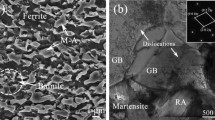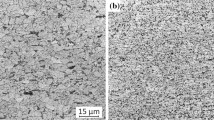Abstract
When the CO2 laser welder with 6 kW output was used to weld 4 TRIP steels, 2 DP steels and a precipitation-hardened steel, which have the tensile strength in the range of 600–1000 MPa, the effect of welding speed on hardening characteristics was investigated. In the weld of TRIP steels and DP steels, the maximum hardness was shown in the fusion zone and the HAZ near the bond line, and the hardness was decreased from the HAZ to the base metal. Only in the PH600 steel, the maximum hardness was shown in the fusion zone and the hardness was decreased from bond line to the base metal. The maximum hardness value was not changed due to the variation of the welding speed within a given range of the welding speed. When the correlation with maximum hardness value using 6 known carbon equivalents was examined, those of CEL (=C+Si/50+Mn/25+P/2+Cr/25) and PL (=C+Mn/22+14B) were 0.96 and 0.95 respectively, and CEL was better because it could reflect the contribution of Si and Cr added to AHSS. The maximum hardness value could be calculated by the equation “Hmax=701CEL+281”. The phase transformation analysis indicated that only martensitic transformation was expected in the given range of the welding conditions. Therefore, the maximum hardness of the weld was the same as that of water cooled steel and not changed with the variation of the welding speed
Similar content being viewed by others
References
L. Hanicke and O. Stranberg, SAE Int. 3, 930028 (1993).
Y. Miyazaki, Proc. 50 th Laser Materials Processing Conference, p.59, Japan Laser Processing Society, Japan (2000).
J. Dearden and M. Okuman, Trans. Int. Weld. 3, 203 (1940).
Y. Ito and K. Bessyo, IIW Doc. 576, 68 (1968).
Y. Ito and K. Bessyo, J. Japan Welding Society 37, 683 (1969).
N. Yurioka, H. Suzuki, and S. Ohshita, Weld. J. 62, 147s (1983).
N. Yurioka, S. Ohshita, and H. Tamehiro, Conf. on Pipeline Welding in 80’s, p.1, AWRA, Melbourne (1981).
Y. Miyazaki and M. Ohara, J. Japan Welding Society 68, 85 (1999).
T. Taka and T. Yamamoto, Proc. 34 th Laser Materials Processing Conference, pp. 113–122, Japan Laser Processing Society, Japan (1995).
S. Kaizu, Y. Shinbo, and M. Ono, J. Japan Welding Society 55, 46 (1994).
M. Ono, A. Yoshitake, and M. Ohmura, Quarterly J. Welding Society 21, 560 (2003).
A. Uchihara and K. Fukui, Quarterly J. Welding Society 23, 541 (2005).
M. Ohara and Y. Miyazaki, J. Welding Society 68, 466 (1999).
H. K. Sung, S. Y. Shin, B. C. Hwang, C. G. Lee, N. J. Kim, and S. H. Lee, Korean J. Met. Mater. 48, 798 (2010).
T. K. Han, S. S. Park, K. H. Kim, C. Y. Kang, I. S. Woo, and J. B. Lee, ISIJ Int. 45, 60 (2005).
M. Xia, E. Biro, Z. Tian, and Y. N. Zhou, ISIJ Int. 48, 483 (2008).
M. Xia, E. Biro, Z. Tian and Y. N. Zhou, ISIJ Int. 48, 809 (2008).
N. YUrioka, ISIJ Int. 41, 566 (2001).
M. Ono, A. Yoshitake, and M. Ohmura, Quarterly J. Welding Society 21, 560 (2003).
B. H. Jung, J. P. Kong, and C. Y. Kang, Korean J. Met. Mater. 50, 230 (2012).
K. Osawa, Y. Suzuki, and S. Tanaka, Kawasaki Steel Technical Report 48, 9 (2003).
T. Saito, Yousetsugijutsu 30, 34 (1982).
N. Saunders, Z. Guo, X. Li, A. P. Miodownik, and L. P. Schille, JOM 55, 60 (2003).
N. Saunders and A. P. Miodownik, CALPHAD (eds. R. W. Cahn), p.1, A Comprehensive Guide, Pergamon Material Series, Oxford, UK (1998).
Z. Guo and W. Sha, Mater. Sci. Eng. A 392, 449 (2005).
D. A. Akinlade, W. F. Caley, N. L. Richards, and M. C. Chaturvedi, Mater. Sci. Eng. A 486, 626 (2008).
A. Sullivan and J. D. Robson, Mater. Sci. Eng. A 478, 351 (2008).
D. Rosenthal, Weld. J. 20, 220s (1941).
D. Rosenthal, Trans. ASME 48, 848 (1946).
D. Tarui, Y. Sakamoto and K. Shibata, J. Japan Welding Society 54, 86 (1994).
D. Tarui, Y. Sakamoto, and K. Shibata, J. Japan Welding Society 54, 46 (1994).
Author information
Authors and Affiliations
Corresponding author
Rights and permissions
About this article
Cite this article
Han, TK., Park, BG. & Kang, CY. Hardening characteristics of CO2 laser welds in advanced high strength steel. Met. Mater. Int. 18, 473–479 (2012). https://doi.org/10.1007/s12540-012-3014-2
Received:
Accepted:
Published:
Issue Date:
DOI: https://doi.org/10.1007/s12540-012-3014-2




